- Books Name
- A TEXT OF BIOLOGY - CLASS XII
- Publication
- ACME SMART PUBLICATION
- Course
- CBSE Class 12
- Subject
- Biology
WHAT IS ADAPTIVE RADIATION?
Galapagos Islands are chain of 22 islands, present on the west coast of South America.
During his journey, Darwin went to Galapagos Islands.
There he observed an amazing diversity among creatures.
Of particular interest, small black birds, later called Darwin's finches, amazed him.
He realised that there were many varieties of finches in the same island.
All the varieties, he conjectured, evolved on the island itself.
From the original seedeating features, many other forms with altered beaks arose, enabling them to become insectivorous and vegetarian finches.
These birds in Galapagos island show differences in bills and feeding habits, but still resemble with the birds present on original mainland.
Hence, we have seen different species have evolved from single common ancestor.

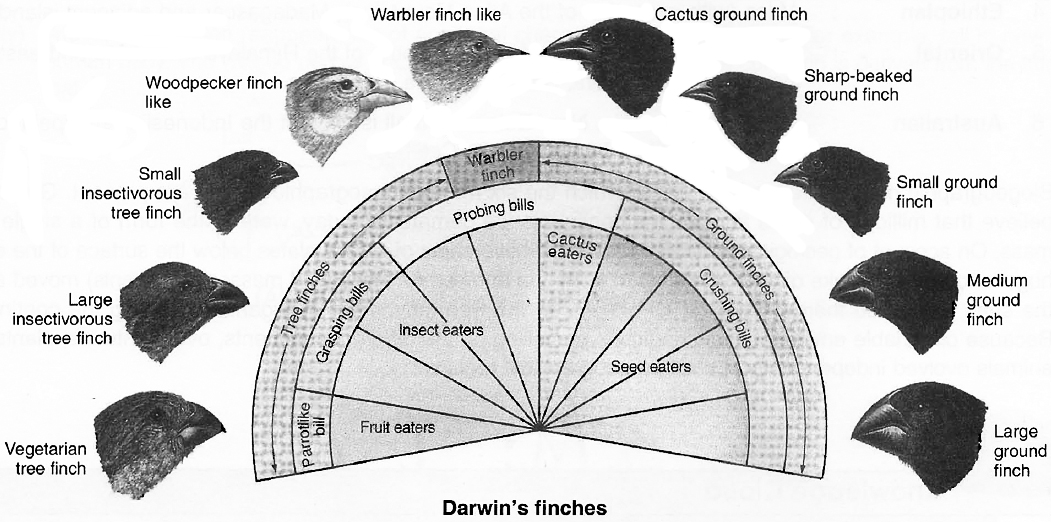
And this process of evolution of differentm species in a given geographical area starting from a point and literally radiating to other areas of geography (habitats) is called adaptive radiation of which the Darwin's finches represent one of the best example.
Concept Builder
The evolution of Darwins finches on the Galapagos Islands is a classic example of species formation and illustrates how adaptation to local conditions produces the divergence, that is the heart of species formation, i.e., such an evolutionary process, giving rise to new species adapted to new habitats and ways of life, is called Adaptive Radiation or Divergent Evolution.
The clusters of species that have been formed on the Galapagos Islands are thus a Tasmanian wolf clear example of species formation arising by microevolutionary divergence from an ancestral form occupying different habitats of microevolution leading to macroevolution.
Another example is Australian marsupials.
A number of marsupials, each different from the others, evolved from an ancestral stock, but all within the Australian continent.
When more than one adaptive radiation appeared to have occurred in isolated geographical areas (representing different habitats), one can call this convergent evolution.
Placental mammals in Australia also exhibit adaptive radiation in evolving into varieties of such placental mammals each of which appears to be 'similar' to a corresponding marsupial (e.g., Placental wolf and Tasmanian wolf marsupial)
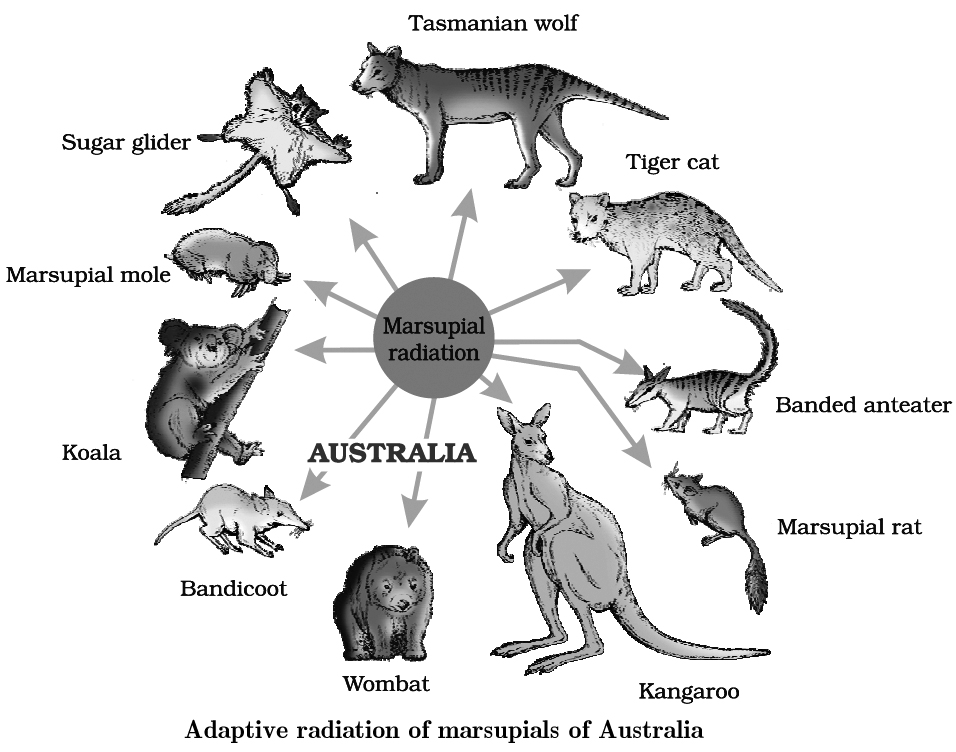
Placental mammals in Australia also exhibit adaptive radiation in evolving into varieties of such placental mammals each of which appears to be 'similar' to a corresponding marsupial (e.g., Placental wolf and Tasmanian wolf marsupial)
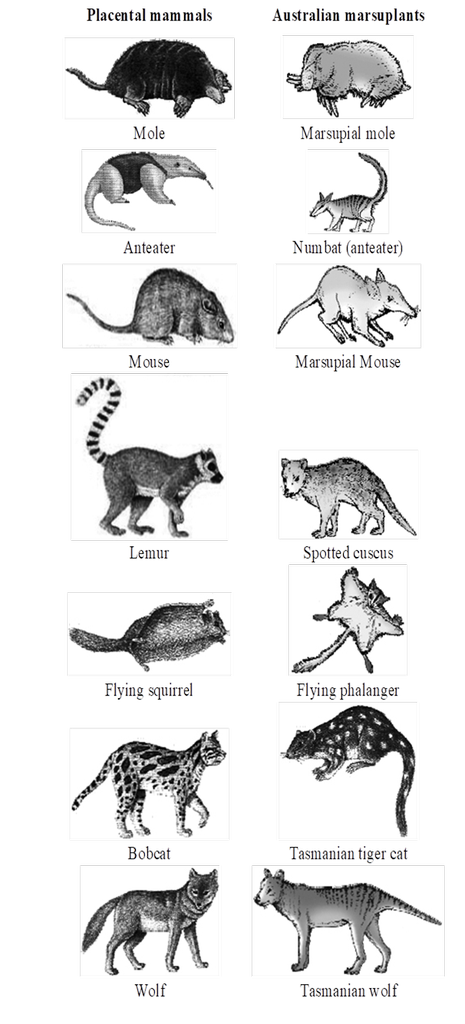
Picture showing convergent evolution of
Australian marsupials and placental mammals
3. EMBRYOLOGICAL EVIDENCES
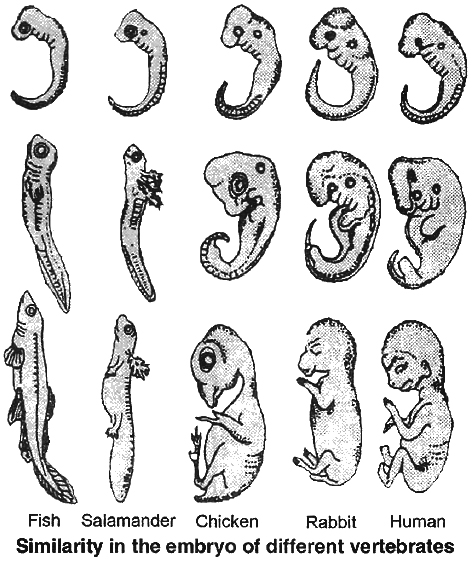
The sequence of embryonic development in different vertebrates show striking similarities.
Gill clefts and notochord appear in the embryonic development of all vertebrates from fishes to mammals.
The notochord is replaced by the vertebral column in all adult vertebrates.
Similarly, gills are replaced by lungs in adult amphibians, reptiles and mammals.
Such similarities in embryonic development once again reinforce the idea of evolution from common ancestors.
Occasionally, embryonic features such as the tail and gill slits persist in adults.
According to Ernst Haeckel, ontogeny (development of embryo) is recapitulation of phylogeny (the ancestral sequence).
This view was summarised by his Biogenetic Law : Ontogeny Recapitulates Phylogeny.
Developmental evidence for evolution is also available from plants.
It is generally believed that mosses and ferns are more evolved than algae.
Protonema of mosses resembles certain green algae.
This provides a clue to their evolutionary relationship.
Both bryophytes and pteridophytes have ciliated sperms and require water for fertilisation.
Gymnosperms do not need water for fertilisation.
But Cycads and Gingko, the primitive gymnosperms, have ciliated sperms like the pteridophytes.
This suggests that gymnosperms have descended from pteridophyte-like ancestors.
The occurrence of ancestral traits in embryo is called Palaeogenesis.
4. PALAEONTOLOGICAL EVIDENCES
Fossils are the remains and/or impressions of organisms that lived in the past last few centuries and palaeontologists have painstakingly built up extensive collections of fossils from all over the world.
The fossil record has helped in building the broad historical sequence of biological evolution.
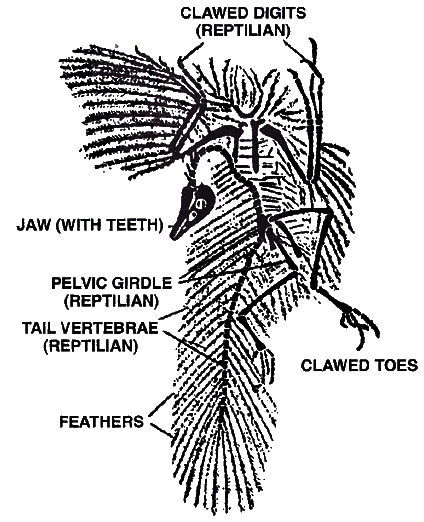
Phylogeny, the evolutionary history of the organism, can sometimes be reconstructed with the help of fossils.
Horse, elephant and man are good examples of relatively complete reconstructions of phylogeny.
Besides form and structure, the habits and behaviour of extinct species can be inferred from the well-preserved fossils.
It is also possible to reconstruct the entire habitat of an organism from fossils.
Fossils also indicate the connecting links between two groups of organisms.
Archaeopteryx shows features of both reptiles and birds.
Reptilian characters of Archaeopteryx.
(a) The body axis is more or less lizard-like
(b) A long tail is present.
(c) The bones are not pneumatic.
(d) The jaws are provided with similar teeth.
(e) Presence of a weak sternum.
(f) Presence of free caudal vertebrae as found in lizards.
(g) The hand bears typical reptilian plan and each finger terminates in a claw.
Avian characters of Archaeopteryx.
(a) Presence of feathers on the body.
(b) The two jaws are modified into a beak.
(c) The fore limbs are modified into wings.
(d) The hind-limbs are built on the typical avian plan.
(e) An intimate fusion of the skull bones as seen in the birds.
By careful analysis of the distribution of fossils in different strata of rocks, the time in history when different species were formed or became extinct can be inferred.
Time Line of Evolution
When scientists first began to study and date fossils, they had to find some way to organise the different time periods from which the fossils came.
They divided the earth's past into large blocks of time called eras.
Eras are further sub-divided into smaller blocks of time called periods, and some periods, in turn, are sub-divided into epochs.
The major geological eras, with their approximate dates in millions of years as given in the table.
"The geological time scale."
Table-I: THE GEOLOGICAL TIME SCALE
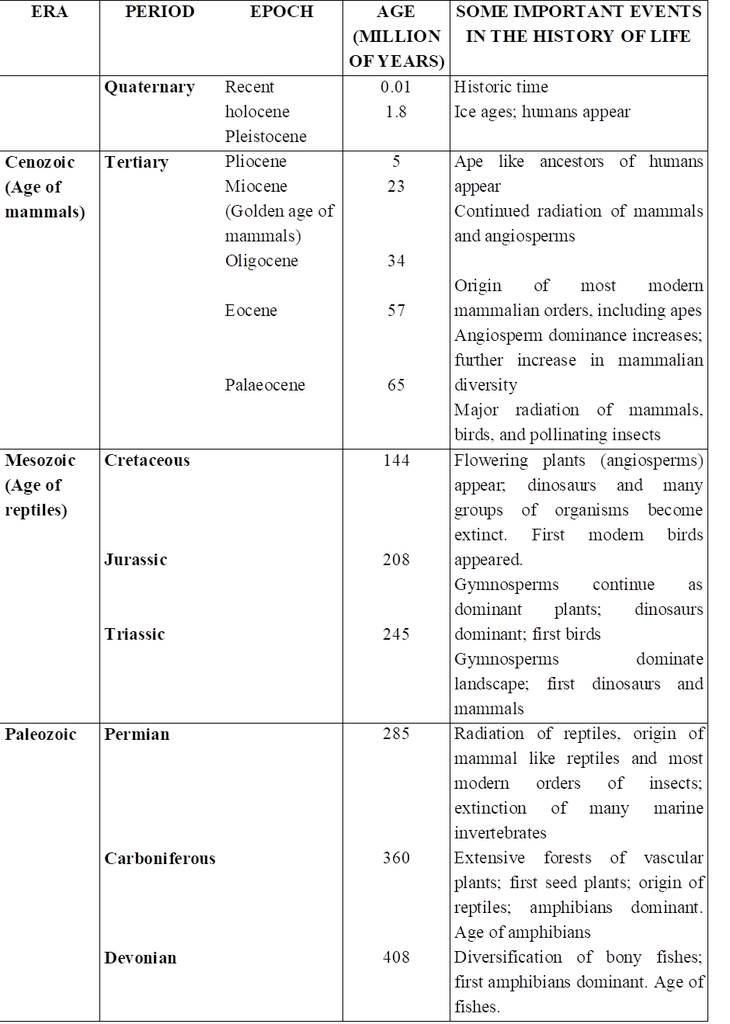
Concept Builder
Types of Rocks –
(a) Sedimentary Rocks –
These are formed at the bottom of ancient oceans by deposition of sediments of sand, lime, coal and minerals which slowly change into hard layers.
Sedimentry rocks are also called as stratified rocks.
Eg. Lime Stone, Sand Stone.
Fossils are mostly found in sedimentary rocks.
(b) Igneous rocks –
Such rocks are formed by ancient volcanic deposits which slowly cooled down and hardened as rocks. Fossiles are absent in it. e.g., Granite rocks.
(c) Metamorphic rocks –
These are formed by change in chemical composition of sedimentary rock and igneous rocks or metamorphosis. Such metamorphosis may be caused by pressure heat and physical movements. e.g. Marble Slate rocks. Fossils are also absent in it – due to chemical changes in the fossils are destroyed.
Types of Fossils
(a) Unaltered Fossils :
In this type whole bodies of extinct organisms are found frozen in ice at the polar regions eg. Wooly mammoths (25000 yrs before extinct fossils were found from Siberian region)
(b) Petrified fossils – Most common type of fossil.
Replacement of organic part by mineral deposits is called petrification.
These fossils consists of only the hard parts e.g. bones, teeth, shells, wood etc. of extinct organisms.
In human body first fossilization occurs of teeth.
(c) Mould fossils –
Here no part of the original organism is present, only an impression of the external structure of body is preserved in wet soil.
(d) Cast fossils –
Sometimes minerals fills in the mould, resulting in cast fossils.
(e) Print Fossils –
Foot print or prints of wings, skin, leaves, stems etc made in soft mud which subsequently become fossilized are a common type of fossils.
(f) Coprolites –
These fossils include the fossil preservation of contents of the intestine or excreta of many ancient animals including particularly the reptiles or fishes.
By studying fossils following facts about organic evolution are evident –
1. Fossils found in older rocks are of simple type and those found in newer rocks are of complex types.
2. In the beginning unicellular protozoans were formed from which multicellular animals evolved.
3. Some fossils represents connecting links between two groups
4. Angiosperms among plants and mammals among animals are highly developed and modern organism
5. By fossils, we can study the evolutionary pedigree of an animal like stages in evolution of horse, elephant and man etc.
Fossil Parks
Our country has rich deposits of fossil plants spanning a gap of 3500 million years.
Twenty million years old fossil forests have been discovered and studied by the Birbal Sahni Institute of Palaeobotany, Lucknow. These forests need to be systematically studied and conserved for scientific understanding and enlightenment. Some of the excellent localities that can be raised to the status of national fossil parks are:
1. Fifty million years old fossil forests preserved in the sediments between the streaming lava flow that poured out into the Deccan country at Mandla district, Madhya Pradesh.
2. One hundred million years old fossil forest located in Rajmahal Hills, Bihar.
3. Two hundred and sixty million years old coal-forming forests in Orissa.
Microfossils and Fossil Fuel Exploration
Palaeobiological study helps in understanding and locating coal and hydrocarbon sources.
Palynofossils -tiny microscopic spores, pollen and other vegetal remains of the past -assist us in interpreting ancient environmental conditions favourable for organic matter accumulation and its conversion to fossil fuels by transformation and subsequent thermal alteration.
By quantitative analysis of microfossils, it is possible to determine the approximate location and configuration of near shore marine deposits, which are in turn responsible for formation and accumulation of hydrocarbons.
The main source of hydrocarbons are phytoplankton, marine and terrestrial algae as well as lipid-rich plant remains.
Thus, the study of fossil plants offers an effective tool in stratigraphical geology and can be exploited in tapping organic fuel resources.
Concept Builder
Dating Fossils
Naturally occurring radioactive isotopes of certain elements are employed in this process.
Such isotopes are unstable and decay over the course of time at a steady rate, producing other isotopes.
One of the most widely employed methods of dating -the carbon -14 (14C) method uses estimates of the different isotopes present in samples of carbon.
Most carbon atoms have an atomic weight of 12.
But a fixed proportion of the atoms in a given sample of carbon consists of carbon with an atomic weight of 14 (14C).
14C is produced from 12C as a result of bombardment by particles from space.
But after an organism dies and is no longer incorporating carbon, its 14C gradually decays over time, by the loss of neutrons.
The common radioactive elements which lose their radioactivity and change into their non radioactive isotopes at a fixed rate are :
1. Potassium40 Argon40
2. Carbon14 Nitrogen14
3. Uranium238 Lead207
4. Rubidium87 Strontium87
6. Thorium232 Lead207
The half life of C-14 is 5730 ± 40 years which means in every 5730 ± 40 years, half of C14 will decay back to N14.
Radioactive carbon can be used to determine the age of fossils upto 70,000 years old.
Half life of potassium40 is 1.3 × 109 years.
Potassium -Argon method is useful because potassium is a common element found in all sorts of rocks.
Potassium decays into Argon extremely slowly.
Electron spin resonance method is relatively most accurate method for dating of fossils.
Evolution of Modern Horse
Eohippus (=Hyracotherium)
The evolution of modern horse began in the Eocene epoch.
The first fossil named Eohippus, 'dawn horse', was in North America.
This horse was about the size of a fox or terrier dog (a type of small dog for unearthing foxes), only 40 cm high at the shoulders.
It had short head and neck.
The fore limbs were with four complete fingers (2, 3, 4 and 5) and one splint of first finger and the hind limbs with three functional toes (2, 3 and 4) and one splint of fifth toe.
Splints are non-functional reduced fingers and toes of horse.
Teeth were with incomplete cement.
Molar teeth had no serrations.
Low-crowned molar teeth were adapted to browse soft lush vegetation.
Mesohippus.
Mesohippus, the intermediate horse, evolved from Hyracotherium about three crore years ago during Oligocene epoch.
It was of the size of modern sheep, about 60 cm high at the shoulders.
Fore feet had three fingers and one splint of fifth finger and hind feet possessed three toes, but the middle one was longer than others and supported most of the body weight.
Molar teeth had some serrations.
Merychippus
Merychippus, the ruminating horse, arose from Mesohippus in Miocene epoch about two crore years ago.
It was of the size of small pony, about 100 cm high at the shoulders.
It had a longer neck.
Its fore and hind limbs had three fingers and three toes, the middle finger and toe being longer than others and supported entire body weight.
There was no splint.
Teeth were longer with cement.
Molar teeth had well developed serrations.
Pliohippus
Pliohippus, the Pliocene horse, evolved from Merychippus in Pliocene epoch about one crore years ago.
It was the size of modern pony, about 120 cm high at the shoulders.
Its each fore and hind limbs had one complete finger and one complete toe and two splints hidden beneath the skin.
Pliohippus is, therefore, referred to be the first one toed horse.
The, molar teeth were long with well developed cement and serrations.
Teeth were adapted for eating grass.
Equus
This is the modern horse which arose from Pliohippus in Pleistocene epoch about nine to ten lakh years ago in North America and later spread throughout the world except Australia.
It is about 150 cm high at the shoulders.
It has a long head and a long neck.
Each fore and hind limb of the modern horse has one finger and one toe and two splints.
The crowns of molar teeth are elongated with enameled ridges and are highly suitable for grinding.
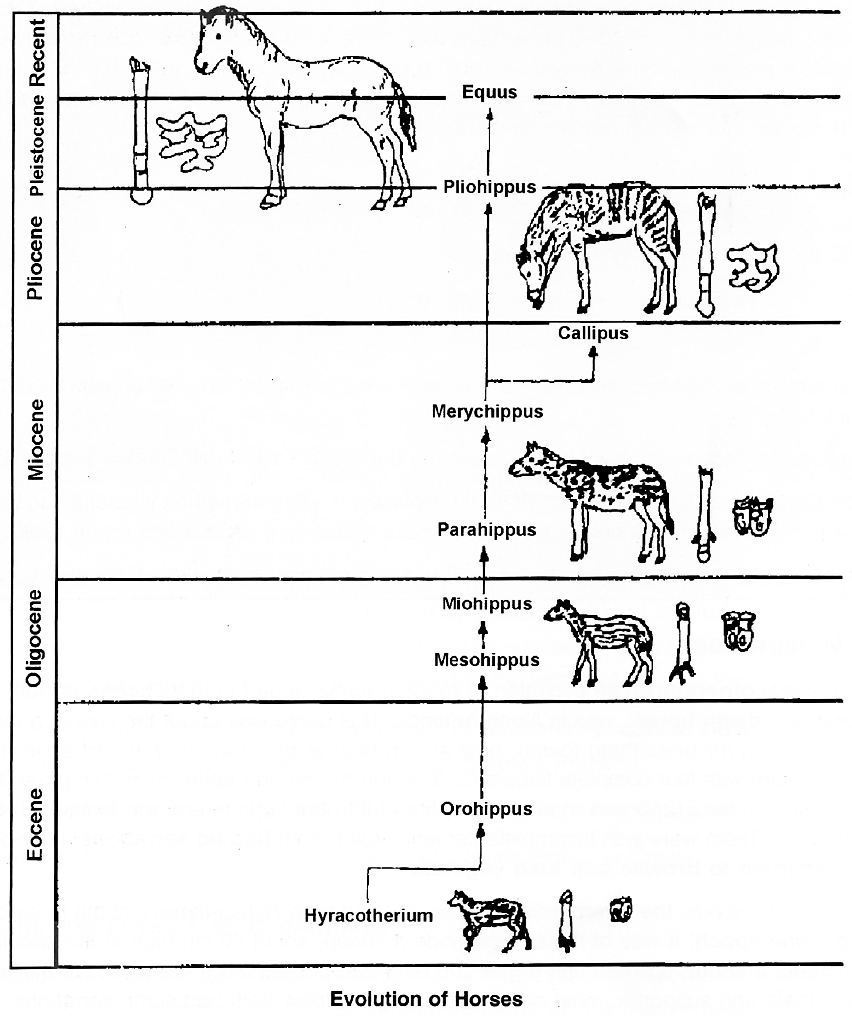
During evolution of horse, there was:
(i) General increase (with occasional decrease) in size,
(ii) Progressive loss of toes,
(iii) Lengthening of toes that was retained,
(iv) Lengthening of limbs in general,
(v) Enlargement of brain, especially cerebral hemispheres,
(vi) Increase in height,
(vii) Increase in the complexity of molar teeth and an enlargement of the last three premolars until they came to resemble molars.
Concept Builder
Connecting Links :
The organisms which possess the characters of two different groups. Examples
1. Proterospongia : A link between Protozoa and Porifera.
2. Neopilina : A connecting link between Annelida and Mollusca.
3. Peripatus : A connecting link between Annelida and Arthropoda.
4. Lungs fishes, e.g., Protopterus, Lepidosiren, Neoceratodus are considered the connecting links between the fishes and amphibians.
5. Egg laying mammals; example duck billed Platypus (Ornithorhynchus) and spiny ant eater (Echidna) are considered connecting links between reptiles and mammals.
Evolution of Vertebrates and Major Groups of Plants
The patterns of evolution of vertebrates and major groups of plants are conspicously different.
The major groups of vascular plants have left relatively small number of fossils which even show gaps (fossilless dark periods).
There are relatively few major lineages, and all the lineages are very distinct from one another.
Instead of showing gradual and continuous change through time, the major lineages appear suddenly in the fossil record.
After that, they persisted with little fundamental change for hundreds of millions of years.
The existence of many of the major subdivisions of the vascular plants living today can be recognised about 345 million years ago on the basis of their distinctive reproductive structure.
All primitive land plants reproduce via tiny spores contained in the sporangia. The major taxonomic groups are distinguished by the position of sporangia on the plant.
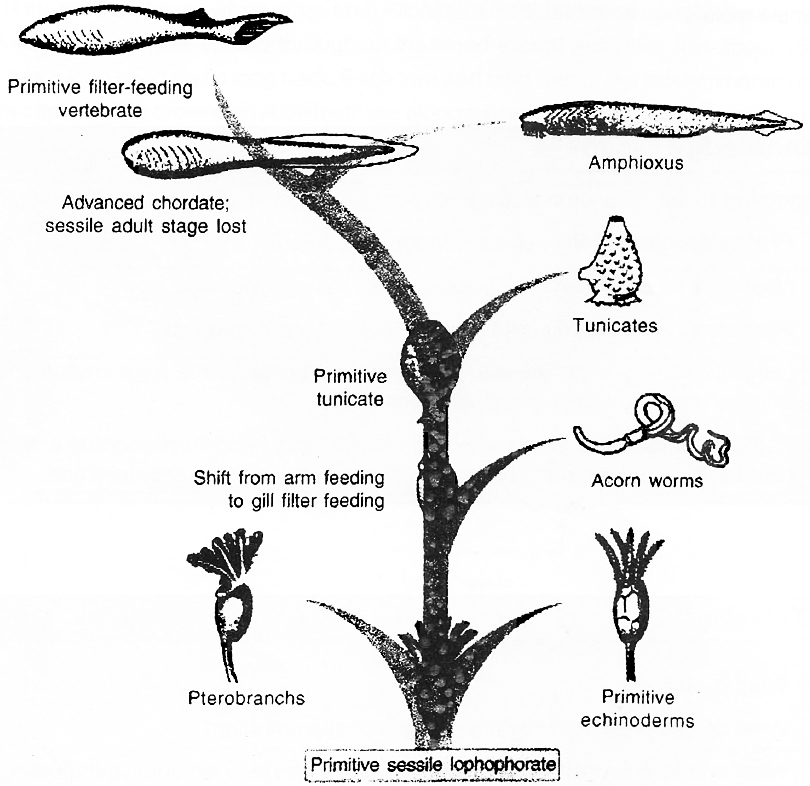
The sporangia are terminal, located at the tip of the plant in the most primitive Psilopsida.
These are placed at the base of the leaves in the Lycopsida (represented in the modern flora by Lycopodium and Selaginella).
The sporangia are arranged in whorls at the top of the plant in Sphenopsida (horsetails).
Fossil evidences document that these basic patterns have been maintained for more than 350 million years.
Few, if any, intermediates are known between these patterns.
The origin of seeds in the land plants was achieved about 345 million years ago in lineages recognised as ancestral to all more advanced vascular plants.
The last major evolutionary advancement among the vascular plants was the emergence of flowering plants (the angiosperms) about 140 million years ago.
But the fossils left no clue as to their ancestors.
The fossil records also indicate that nearly all the living orders of angiosperms and most of the characters of their modern-day representatives evolved from them.
The continuous change of a character within an evolving lineage is termed as evolutionary trend.
A lineage is an evolutionary sequence, arranged in linear order from an ancestral group to a descendant group.
The number of trends in any lineage is, therefore, same as the number of characters evolving.
A trend may be progressive (a general increase in size of organs) or retrogressive (a general degeneration and loss of organs).
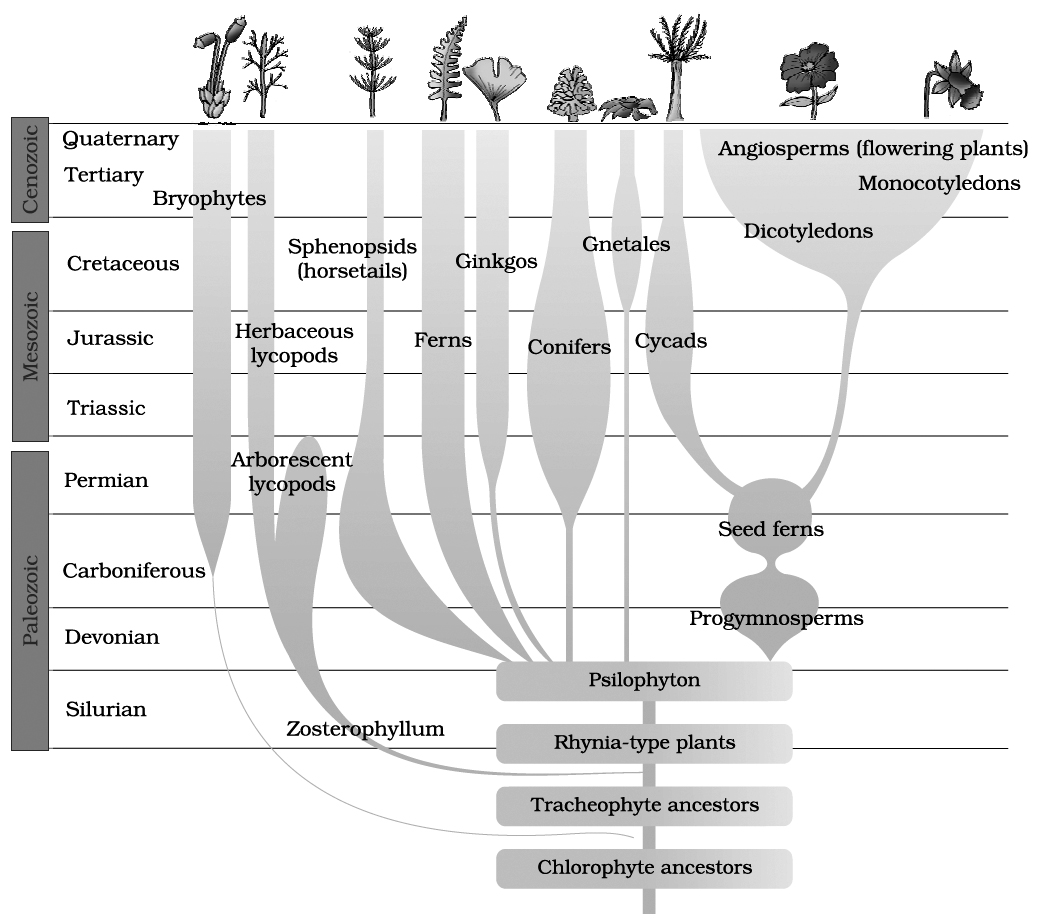

 ACME SMART PUBLICATION
ACME SMART PUBLICATION
